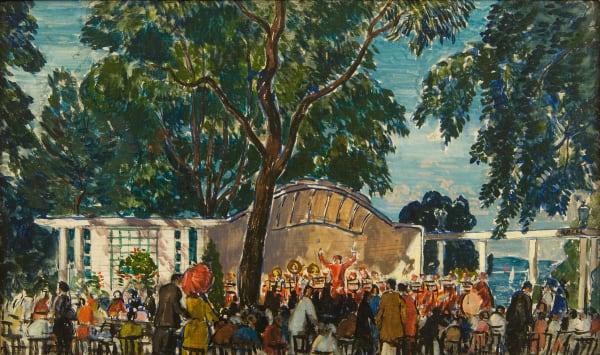Works
Biography
Gifford Beal enjoyed a long and successful career painting New England landscapes, scenes of daily life in New York City's parks, and images of the circus. Beal was born into an artistic household in the Bronx, New York's northernmost borough. His older brother, painter Reynolds Beal (1866–1951), introduced him to the progressive ideas of painter William Merritt Chase, with whom Gifford began studying when he was only twelve years old. He graduated from Princeton University in 1900, and then returned to New York to spend two years at the Art Students League. Beal later served as the League's president, from 1916 to 1929, and taught there in 1931–32.
Beal began exhibiting in 1901, while still an art student, and he almost immediately met with success, receiving numerous prizes and medals by the time he was elected a member of the prestigious National Academy of Design in 1914. Based in New York City, the artist summered in the Hudson River Valley and at various picturesque spots on the coasts of Maine and Massachusetts, where he found artistic subjects in the life of the local fisherfolk. He also painted watercolors in the Caribbean and in West Africa. Thoroughly representational, Beal's paintings range widely in style, from the bright color, broken brushwork, and light effects associated with impressionism to bold, blocky forms that show the influence of modernist masters. His scenes of life in circuses, at urban parks, and on the New England shore are vigorously painted and cheerful in tone.
During the Great Depression, Beal was commissioned by the U.S. Department of the Treasury Section of Fine Arts to paint two murals for the Department of the Interior Building in Washington, D.C., and another for the post office in Allentown, Pennsylvania. He also painted a mural series for Princeton honoring physicist Joseph Henry. Beal was a sought-after member of artists' juries and served on advisory boards of several arts organizations. His niece Marjorie became the wife of important modern art collector Duncan Phillips, and the couple acquired many of Beal's works for their museum, the Phillips Collection, founded in 1921. Beal's paintings and works on paper joined the collections of numerous other important art museums, and he was the subject of several retrospective exhibitions in the years just before his death, at the age of seventy-seven. Beal's career is relatively well documented, although his activity as a printmaker awaits further examination.
Beal began exhibiting in 1901, while still an art student, and he almost immediately met with success, receiving numerous prizes and medals by the time he was elected a member of the prestigious National Academy of Design in 1914. Based in New York City, the artist summered in the Hudson River Valley and at various picturesque spots on the coasts of Maine and Massachusetts, where he found artistic subjects in the life of the local fisherfolk. He also painted watercolors in the Caribbean and in West Africa. Thoroughly representational, Beal's paintings range widely in style, from the bright color, broken brushwork, and light effects associated with impressionism to bold, blocky forms that show the influence of modernist masters. His scenes of life in circuses, at urban parks, and on the New England shore are vigorously painted and cheerful in tone.
During the Great Depression, Beal was commissioned by the U.S. Department of the Treasury Section of Fine Arts to paint two murals for the Department of the Interior Building in Washington, D.C., and another for the post office in Allentown, Pennsylvania. He also painted a mural series for Princeton honoring physicist Joseph Henry. Beal was a sought-after member of artists' juries and served on advisory boards of several arts organizations. His niece Marjorie became the wife of important modern art collector Duncan Phillips, and the couple acquired many of Beal's works for their museum, the Phillips Collection, founded in 1921. Beal's paintings and works on paper joined the collections of numerous other important art museums, and he was the subject of several retrospective exhibitions in the years just before his death, at the age of seventy-seven. Beal's career is relatively well documented, although his activity as a printmaker awaits further examination.
Exhibitions
Publications
Enquire





